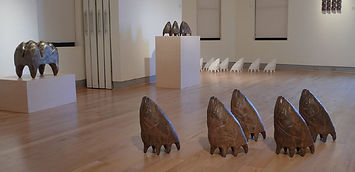


Colette Hosmer (USA)
Contemporary naturalist who is celebrated internationally for her outdoor sculptures and installation work with organic materials. Born in 1946, Hosmer grew up in a small town in rural North Dakota. She studied art at the University of North Dakota and at Linn Benton College. Hosmer worked as the director of Shidoni Gallery in Santa Fe, New Mexico before beginning a professional career as an artist at the age of 44. Since then Hosmer’s work has been exhibited in prestigious museums throughout the world. Her work is among the permanent collections of the City of Xiamen, China Tianjin, China; City of Yanqing, China; New Mexico Museum of Fine Arts, Santa Fe, NM; The Albuquerque Museum – Albuquerque, NM: The Eitlejorg Museum, Indianapolis, IN and Contemporary Artspace – Potsdam, Germany.
China and Hafnia Foundation
"An invitation from the Chinese Ministry of Culture to attend a monumental sculpture symposium in 2000, was to be the first of my ten art-related adventures in China. The 10th and most recent experience took place in late 2010, on tiny Gulangyu Island, located off the coast of China in the Taiwan Strait.
Some of my previous art-related invitations from China included the first Beijing Biennale, three monumental sculpture symposiums resulting in monumental works in Tianjin, Yanqing and Xiamen, as well as an Art/Science Seminar and Exposition at Tsinghua University in Beijing. In recent years I have enjoyed the challenge of creating and producing smaller, more intimate bodies of work while living in China so I was elated when I received an invitation from Stevens Vaughn, Founder and Director of the non-profit, Hafnia Art Foundation, to spend several months living and working in his Villa on Gulangyu Island.
The island is granite, hilly and covered with sub-tropical foliage. The Villa is a century old and primarily un-restored ... perfect. I prefer to work with basic tools, materials and methods, so the fact that automobiles and even bicycles are forbidden on Gulangyu Island facilitated my desire to work primitively. All materials and goods on the island are transported by "Cart Men" pulling heavy wooden two- wheeled carts. I converted one of the abandoned servant's quarters behind the Villa into a studio, supplied it with plaster and clay, and began to work. Lao Liu, the old caretaker spoke no English, so my minimal Mandarin, hand signs and an occasional drawing (always a cause for great amusement) had to suffice.
I made molds of animal parts which I purchased on my daily trips to local food markets. Chinese friends volunteered to let me make molds of their faces. In one case I enlisted a Chinese laborer who was working on the repair of an old building across the lane to sit for the mold process. I was touched, every time, by the trust it took for these people to allow me to put them in such a vulnerable position for long periods of time.
There are few places left in the world where time moves at a truly human pace. A trip to the mainland required a mile walk to the ferry, a wait for the boat, a trip across the channel and then a bus or taxi ride to one's destination. The return trip was straight uphill from the ferry, through winding granite lanes, up countless granite steps.
I read somewhere that "technology dispels physical discomfort but we must develop spiritually to balance the outer development of material technology". This is an apt description of the opportunity offered by Hafnia Foundation's Gulangyu Island Residency"
Collete Hosmer
